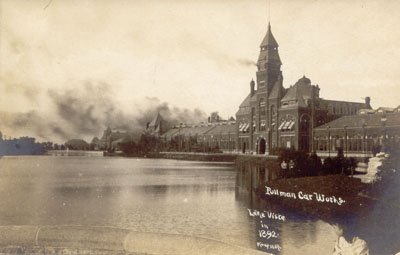|

The Administration Building, 1892 |
The Pullman Palace Car Company was granted a charter by the Illinois
legislature on February 22, 1867. With the creation of the Town of Pullman
and the Pullman Factory site in 1881, the company flourished under George
Pullman's guidance until the Strike of 1894 and George Pullman's death in
1897. Robert Todd Lincoln was the next President of the Pullman Company
and under his leadership the company name was changed in 1899 to The
Pullman Company. As the company grew, a holding company, Pullman, Inc. was
chartered in 1924, as well as The Pullman Car & Manufacturing Corporation.
In 1934, the Pullman-Standard Car Manufacturing Company was formed as a
conglomerate of other subsidiaries around the country and the company
continued to operate under this name until the Chicago operation closed in
1982.
Pullman bought 4,000 acres of land, of which five hundred were used to
build the factory. Work began in April of 1880, with the Allen Paper Wheel
factory the first building completed. By March 1881, the company had
expended $1.3 million for land, car works, buildings, machinery, housing
and other improvements. By the turn of the century train car production
had evolved from wooden cars to heavyweight steel construction and many of
the 1881 buildings had to be retrofitted to accommodate the larger cars
being built. In 1907 the south wing of the Administration Building was
enlarged to accommodate construction of larger cars. Many Pullman factory
buildings were lost starting during the late 1950's. Today only the
central core of the Administration Building/Clocktower and its north wing
remain, along with a portion of the erecting shops on the east.
Pullman chose a location remote to Chicago for his factory and town
thinking it would shield his workers from labor unrest. But the 1870s and
1880s were a period of upheaval for all workers and there were many small
strikes in various Pullman shops during George Pullman's time. The most
famous is the Pullman Strike of 1894. When the American Railway Union
struck against the Pullman Palace Car Company, it involved Federal Mail
cars which prompted Federal troops to camp outside the Hotel Florence.
Although there was no actual bloodshed took place in Pullman, George
Pullman refused to negotiate with his employees and refused to lower rents
despite lowering wages. Three years later George Pullman was dead, a
broken man now known for his mistakes rather than his innovations.
|

